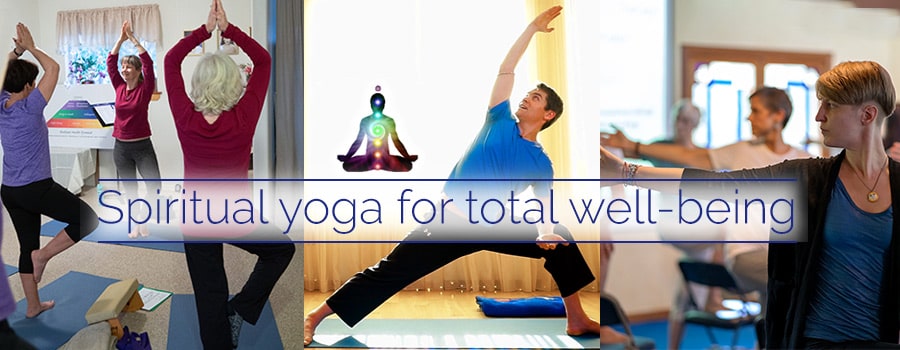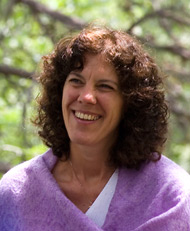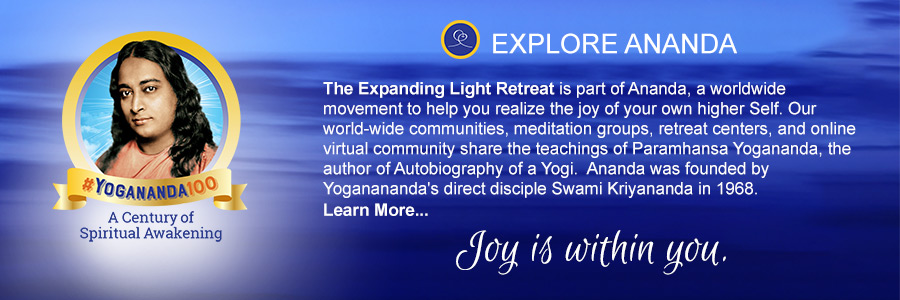Gyana Yoga — The Yoga of Wisdom
Part 3 of Asanas Can Teach Us the Deeper Side of Yoga
Gyana (sometimes written jnana) is wisdom, the goal of all learning and knowledge.
On one level, it is higher awareness gleaned from life’s experiences. As each one of us goes through the “school of hard knocks” known as life, we learn, grow and understand more. We hopefully garner wisdom: a perspective on life — and on ourselves — that is increasingly centered in truth.
On a deeper level, which is particularly relevant to us as yogis, wisdom emerges from within as the fruit of the revelations of the soul.
Every one of us possesses wisdom on a soul level. It will, however, remain undiscovered so long as we lack discrimination, and are restless and ego-centered.
Developing Discrimination
Wisdom first comes through the practice of viveka (discrimination), says Swami Kriyananda in The Art and Science of Raja Yoga. This practice can easily be applied to the practice of the yoga postures.
When we put out energy to learn in any field — what to speak of becoming a teacher in that field — there is always the possibility that we might become proud of the knowledge we acquire. In an effort to sound like the expert we want to become, we end up sharing our knowledge of yoga, but compromising vibration and the opportunity to tune into the uniqueness of each individual.
To counter this tendency we need to direct our attention to the essence of yoga, and to our own realization of its core truths. In Autobiography of a Yogi, Paramhansa Yogananda quoted the ancient sage Shankara: “realized knowledge alone destroys ignorance — knowledge cannot spring up by any other means than inquiry. Who am I? How was this universe born? Who is its maker? What is its material cause?”
Yogananda added, “The intellect has no answer for these questions; hence the rishis [sages] evolved yoga as the technique for spiritual inquiry.”
As we practice Ananda Yoga®, we should periodically ask ourselves similar — though much less grandiose — questions, such as: “Why am I doing this? How long should I hold this pose? How far should I stretch? How is my mind reacting? Is the pose expanding or contracting my consciousness?”
Feel for the answer to these questions from a place of deep inner awareness and sensitivity to the highest wisdom of the moment. In this way, through careful and relaxed observation (which is an element of the practice of Gyana Yoga), we move our practice ever closer to the essence of yoga.
Asana Affirmations as Gyana Yoga
In The Art and Science of Raja Yoga, Swami Kriyananda says, “The gyana yogi tries, even at the time of outward enjoyment, to interiorize his consciousness, feeding the inner flame of soul-consciousness. He knows that if, like worldly people, he borrowed its embers to give light to things, the true source of joy within himself would burn itself down at last to gray ashes.”
Asana affirmations are of great benefit in this regard, and they’re wonderful tools to help your students begin to experience — rather than simply hear about — the practice of Gyana Yoga. The affirmations direct our consciousness away from the periphery of our practice into the heart of the yoga experience.
For instance, in Padahastasana (Jackknife Pose), we affirm: “Nothing on earth can hold me!” The position of the body is one of relaxing, letting go, as though we were shedding layers.
Without a reminder to go inside, however, it’s easy to spend the entire pose wishing our hamstrings would lengthen already! But the affirmation (if we participate fully in it) reminds us to look within ourselves — not merely beyond our bodies, or people’s opinions, or other outward influences of this world, but beyond our samskaras (natural tendencies/ inclinations), our likes and dislikes, our opinions, our habitual reactions to life — to the central truth in everything. In Gyana Yoga, truth becomes more important than being right or knowing all the facts.
Or consider Garudasana (Eagle Pose), which does a great job of reflecting our lives. Just as we get all twisted up in a swirl of activities, conflicting priorities, seeming emergencies, never enough time — in short, in confusion — so in Garudasana we can easily get caught up in winding our limbs farther and farther. The thought comes, “If I can just get my palms together, then I’ll be doing the pose so much better!”
But isn’t our inner awareness the true measure of how well we’re doing a pose? Far better, then, to focus on the unmoving center of the pose — the spine — and in so doing, call our attention to the unmoving, calmly observing center of all life’s movement: the soul. All the masters tell us that we are that center, so let’s identify with it: “At the center of life’s storms, I stand serene.”
Wisdom is Born of Calmness
To develop wisdom, one must develop calmness. Only through calmness can one become deeply centered in the Self.
The cervical center (the Vishudha Chakra) is the seat of spiritual calmness in the body. If our energy is directed inward and upward at this center, we experience calm. If it is directed outward or downward we experience restlessness. The quality of energy at this chakra directly affects our reactive process.
We have all experienced being challenged in life, and the difference between responding appropriately because calm, versus inappropriately because agitated. Whether we receive life’s experiences through the filter of calmness or the filter of restlessness greatly determines the outcome. With this in mind, of course we want to develop greater calmness. Yoga postures are a powerful aid in this regard.
You can direct your students toward a deeper state of calmness — and thus wisdom — by leading them in postures that stimulate the energy of this chakra to move inward and upward.
Examples would be: the Simhasana (lion pose), neck/throat rechargers, Sarvangasana (shoulderstand), Halasana (plow pose). Another example is a variation of Sasamgasana (hare pose) in which we slowly bring the body up with an awareness in the spine of each vertebrae righting itself on the one below. When in full position, the neck is drawn tightly into the throat, stimulating the cervical chakra.
For me, one of the most rewarding benefits of Ananda Yoga® is that it helps to clarify my mind and harmonize it with my soul. I find it easier to say what I mean, to speak from my heart, to be inclusive, understanding and compassionate. These are all attributes of wisdom.
Invite your students to discover this relationship for themselves. Ask them about their exchanges with others in the workplace or with family. Are those exchanges different after their practice of yoga? You know they are, but your asking will help students “put 2 and 2 together.” That’s an important aspect of Gyana Yoga: linking cause and effect.
A great time to sow the seeds of wisdom is at the close of your routine, during and after savasana. Introduce your students to Swami’s Secrets of Life CD [out of print, but available at online music stores] by playing a selection; my favorite is “Secrets of Inner Peace.”
The calmness they will have gained in their practice will allow them to feel his affirmations on peace as a natural state of consciousness within themselves, one that has always been with them — and always will be.
Renouncing My Little Egoic Self, I Expand with My Great Soul Self Everywhere
In Rays of the Same Light (Vol. 3), Swami Kriyananda says, “Gyana Yoga begins and ends with the task of demolishing the sense of ‘I’ and merging it into Divine Consciousness.” This is no small undertaking, but even in simple asanas we can begin moving in this direction.
I once had a yoga student who was paralyzed from the waist down. Without any prior inquiry as to whether Hatha Yoga would be appropriate or even helpful to her, she just showed up! I was immediately taken with her enthusiasm, warmth, spirit, and complete faith that yoga would be of great benefit to her.
I fumbled around a little at first, making an extra effort to help her so she wouldn’t feel left out, while also leading the rest of the class in a manner they had come to expect. To my surprise I watched her following with ease, naturally making adaptations that were true to the essence of each pose. Clearly there was a lot she couldn’t physically do, but as she told me later, she would do it mentally and felt great benefit.
She was very excited about what she was experiencing, and the possibilities that it foretold. I was so inspired by her understanding and wisdom. In getting herself — and her considerable physical limitations — out of the way, suddenly the whole universe lay wide open before her!
Awakening the Spiritual Eye
As you know, in the physical body, the seat of the intellect is the frontal lobe of the brain — specifically, the point between the eyebrows. Concentration at this center, however, potentially stimulates levels of awareness far beyond the intellect. In the science of yoga, this is the seat of ecstasy, spiritual vision, and the highest wisdom. Hence its name, the Spiritual Eye.
The Spiritual Eye is not imaginary. We can, in fact, see it in meditation, when the thoughts are stilled, and when the intellect functions on its own higher, intuitive level. Paramhansa Yogananda said that we can grow very quickly by keeping our awareness focused at the Spiritual Eye. It is the positive pole of the Ajna Chakra.
Awakening the Spiritual Eye is one of the goals of yoga and meditation practice. It is meaningful to note that Kriyananda defines “awakening of a chakra” as the total withdrawal of energy from the periphery and senses into the deep sushumna (astral spine) and then upward through that chakra to the spiritual eye. In regard to the Spiritual Eye itself, this would mean a very high state of realization. Here, let’s use “awaken” to mean doing what we can to focus and act more from a center of awareness at the Spiritual Eye.
Guide your students to experiment with this when practicing pranayama and asanas. During the pauses between poses, and during deep relaxation, ask your students to inwardly observe the energy as it withdraws naturally — and better still, to use their will to help it withdraw — from the periphery of the body and senses, into the spine and up to the Spiritual Eye. Then ask them to hold their concentration there. Even though this practice takes a high degree of sensitivity and attentiveness, it will prove far more restful than what students will otherwise tend to do: drift into daydreaming, planning or worrying. In addition, it will prepare them to experience higher states of consciousness and help develop wisdom.
I’d like to share with you a meditation exercise from Swami’s book, Awaken to Superconsciousness. You might find it helpful for awakening the Spiritual Eye. Gyandev McCord used it for the deep relaxation at the end of his video, Yoga to Awaken the Chakras; try it with your own classes.
“Concentrate at the point between the eyebrows. Visualize a tunnel of golden light. Mentally enter that tunnel, and feel yourself surrounded by a glorious sense of happiness and freedom. As you move through the tunnel, feel yourself bathed by the light until all worldly thoughts disappear.
“After soaring through the tunnel, visualize before you a curtain of deep violet-blue light. Pass through that curtain into another tunnel of deep, violet-blue light. Feel the light surrounding you. Slowly, the tunnel walls disappear in blue light. Expand your consciousness into that light — into infinite freedom and bliss.
“Now there is no tunnel. There is only the all-encompassing blueness and bliss of infinity.
“At last, visualize before you a silvery-white, five-pointed star of light. Mentally spread out your arms and legs, assuming with your body the shape of that star. Give yourself to it in body, mind and soul as you surrender every thought, every feeling to absolute, Self-existing Bliss. Bliss cascades gently over you, like a waterfall of mist, filling your heart with ineffable peace.”
Whether or not you behold the Spiritual Eye, by meditating at that point your consciousness will gradually rise until at last it passes the portals of human awareness and enters the state of ecstasy, or superconsciousness.
The Union of the Yogas
Raja Yoga, the royal yoga, is the bringing together of the practices of Bhakti, Karma and Gyana Yoga, with meditation as the supreme guide. Meditation will enhance our devotion, our activities, and our divine understanding. Conversely, as we practice these three yogas, each will in turn help to guide our meditation toward the goal of Raja Yoga: liberation.
This also is the goal of Ananda Yoga; hence its full name: “Ananda Yoga for Higher Awareness.” It’s all so simple! Harmonious movement, pranayama to stimulate the life force, affirmations to focus and purify our hearts and minds. Practicing in this way, even those who are less inclined toward meditation find themselves naturally drawn to it, and more comfortable with it than they ever thought possible.
Recently a friend of many years came to visit us. His wife had passed on shortly before. She was, in fact, one of Sacramento’s first yoga teachers some 50 years ago. Feeling a great sense of loss, he asked us to teach him how to meditate. He had always been afraid of meditation because once he had had a deep experience and felt himself outside of his body. We practiced some postures and preparatory pranayama, and then meditated.
His experience this time was very different. He felt a level of relaxation he had never before experienced, and consequently he was no longer afraid. He found his consciousness at peace with ease at the point between the eyebrows. Established here, in the wisdom of his soul, all fear and anxiety fled. He was in the joy of all understanding.
Concluding Thoughts
Formulating these three articles on the Deeper Side of Yoga has been greatly inspiring to me personally — and I hope to you. To the best of your ability, seek an ever deeper experience in your personal practice. Then you will find that you are giving to others in a way that is transforming and lasting — for them and for you. Let’s all help each other to keep going deeper into the “Ever-New Joy” of awakening in Spirit.
Related Articles
All authors are graduates of Ananda Yoga Teacher Training.





















